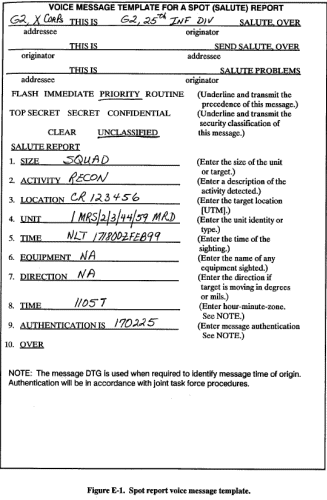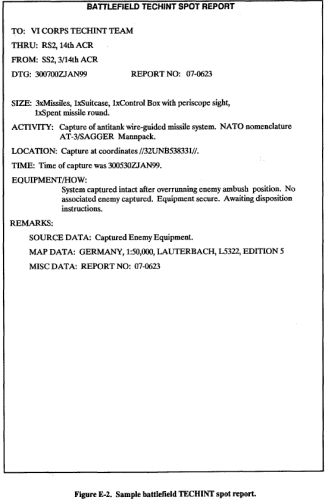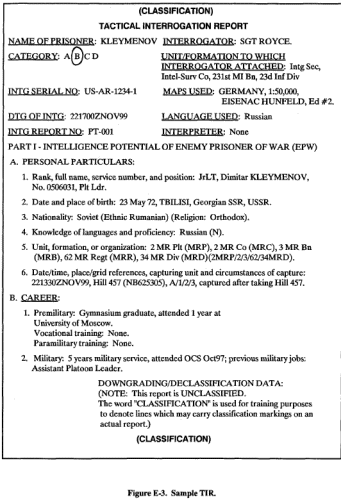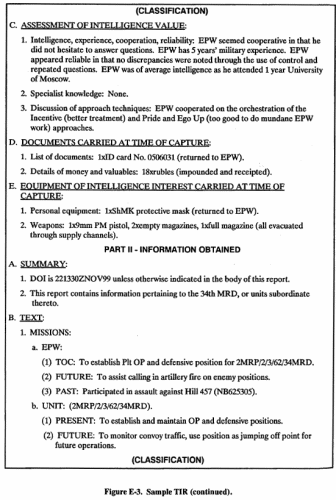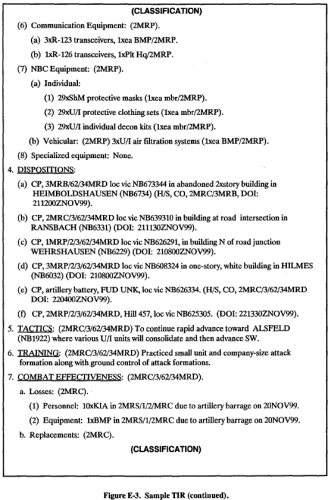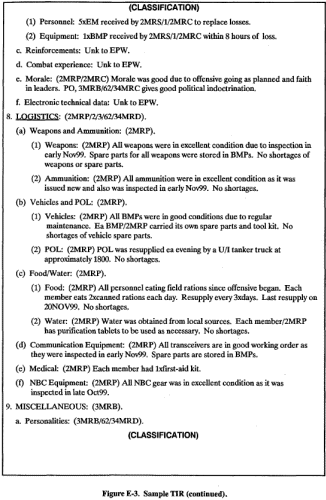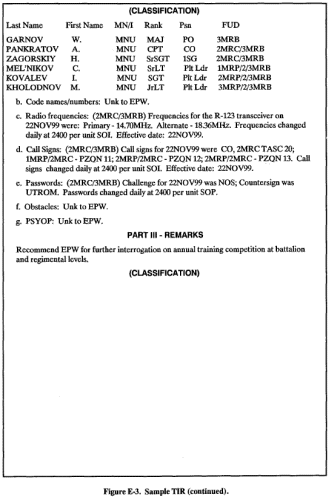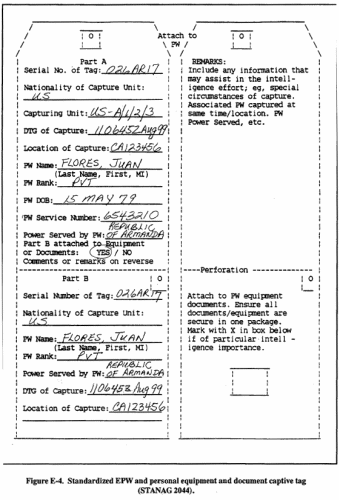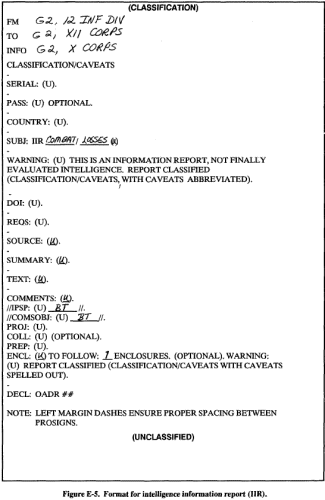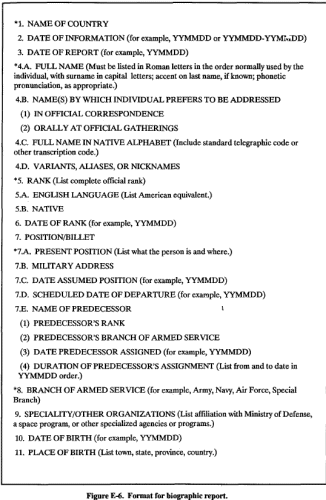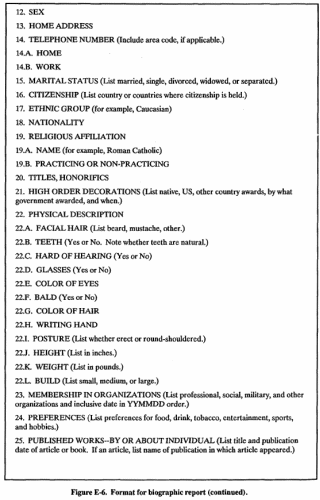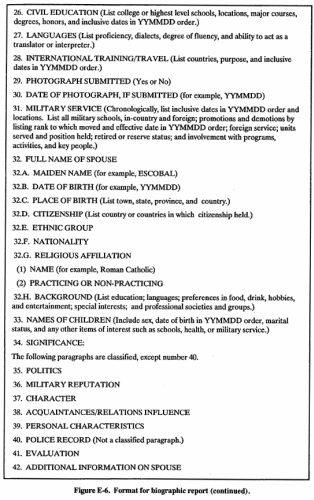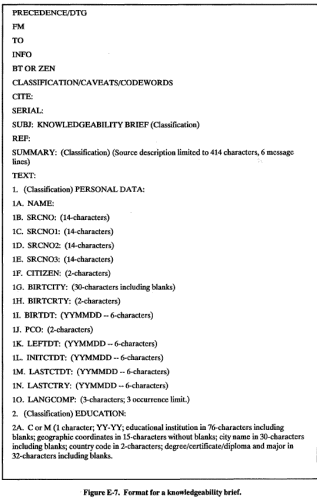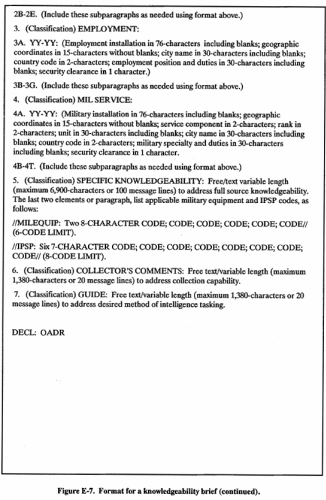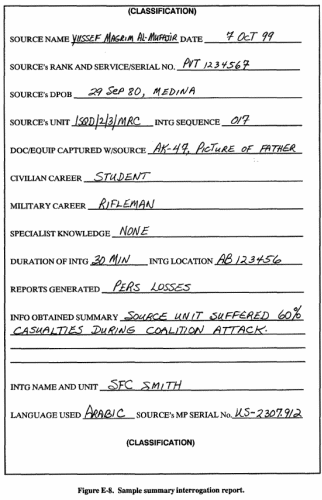|
Site Map FM 34-52 INTELLIGENCE INTERROGATION -- SEPTEMBER 28, 1992 |
|
APPENDIX E:
REPORTS In addition to reports previously covered, there are other reports prepared or used by interrogators in tactical and strategic units. DIAM 58-13 is the authority for format and preparation of intelligence information reports (IIRs), biographic reports, and knowledgeability briefs (KBs). Local SOPs guide the interrogator in preparing other reports. Message Text Format (MTF) Editor is software used by the military services, National Security Agency (NSA), and Defense Intelligence Agency (DIA). MTF Editor --
The SALUTE report format contains relevant information necessary to alert higher commands of an incident or relevant information obtained. It answers all basic interrogatives: Who, What, When, Where, How, and Why. Figures of sample reports, formats, and tags used by interrogators are listed below:
TACTICAL INTERROGATION REPORT The TIR (Figure E-3) serves as written summary of initial or subsequent interrogations. The term "tactical interrogation report" was adopted under NATO STANAG 2033. The TIR --
In the heading, the EPW will be classified according to one of four categories explained in Chapter 4 under document exploitation. The first section of the report contains the source's name and category, interrogation serial number, date, report number, interrogator's name and unit, maps and language used, and interpreter's name (if one is used). The second section, Part 1, contains the EPW's personal particulars, career, assessment of intelligence value, capture data from the captive tag, and documents and equipment found on the EPW. The third section, Part II, lists information obtained from the EPW during the interrogation regarding missions, composition, strength, dispositions, tactics, training, logistics, combat effectiveness, electronic technical data, and miscellaneous data. BIOGRAPHIC DATA ENTRIES The following data prosigns are used in biographic reporting. If available, biographic information will fit in the summary of the IIR; the text entry will be NONE. Should the reportable information exceed the limitations of the summary, entries will be made in the text. When making entries, ensure that the numbers and prosigns shown here are those used in the biographic report; if you have no data for a particular item, skip it and list the next item for which you have a data entry. Items skipped are not listed on the report. The paragraph classification follows the biographic prosign. Do not use colons to separate the prosign and data entries. Minimum essential data (MED) prosigns are asterisked. SUMMARY INTERROGATION REPORT The rationale behind the summary interrogation report, shown at Figure E-8, is to preclude duplication of effort. In DESERT STORM, as EPWs were being evacuated up the chain, the gaining interrogator would ask questions only to be told the same questions had already been asked by somebody else at a previous location. This is embarrassing, and does not foster rapport building, because the gaining interrogator had no previous EPW screening or interrogation reports. It was assumed this was the first time the EPW was questioned. If the previous echelon received EPW information pertaining only to their immediate tactical situation, with no reports being forwarded, it would have been to the gaining interrogators advantage to be apprised of what transpired at the lower echelon; hence the summary interrogation report. This report is simple in design and purpose, but reveals EPW information that gives the gaining interrogator insight as to what was developed at the previous echelon. Figure E-1. Spot report voice message template. Figure E-2. Sample battlefield TECHINT spot report. Figure E-3. Sample TIR. Figure E-3. Sample TIR (continued) Figure E-3. Sample TIR (continued). Figure E-3. Sample TIR (continued). Figure E-3. Sample TIR (continued). Figure E-4. Standardized EPW and personal equipment and document captive tag (STANAG 2044). Figure E-5. Format for intelligence information report (IIR). Figure E-6. Format for biographic report. Figure E-6. Format for biographic report (continued). Figure E-6. Format for biographic report (continued). Figure E-7. Format for a knowledgeability brief. Figure E-7. Format for a knowledgeability brief (continued). Figure E-8. Sample summary interrogation report.
|
